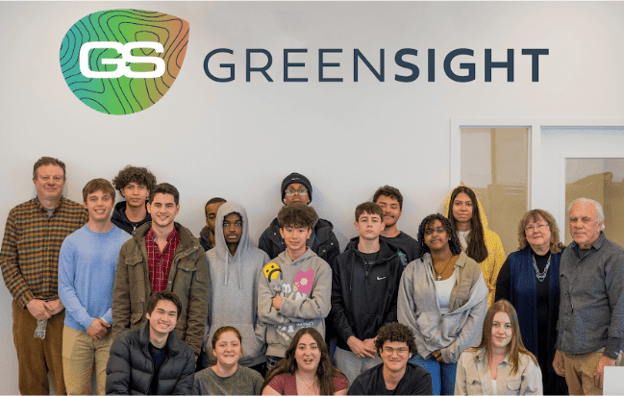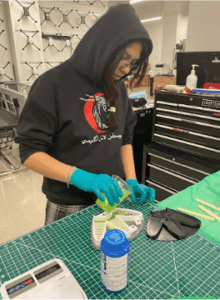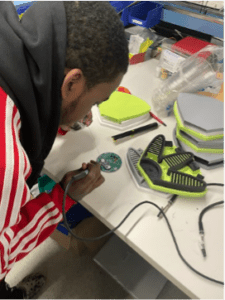
A SeaJelly Robotics BootCamp with Boston Students
A SeaJelly Robotics BootCamp with Boston Students
During the Boston Public School’s (BPS) Winter Vacation, February 20 – 22, GreenSight was host to a Robotics Bootcamp at our Boston facility; nine (9) BPS students participated. Guided by seven members of our staff, the students took a deep dive into aquatic robotic technologies as they worked together to build their first SeaJelly.
While the students learned how to mold silicon rubber components, solder electronic circuits, and program real time processors, the GreenSight staff participants learned better ways to communicate concepts and teach skills. However, the most important thing we learned is that building a SeaJelly really is fun; the students’ enthusiasm was high, and they enjoyed all three days. (So did we!)
SeaJelly bootcamp students and instructors
Key to Moving Our Project Forward
The overall project vision is to create an ecosystem of STEM education tools and resources based upon soft aquatic robots that attracts the attention of and educates students K-12 and beyond. SeaJelly is the project’s first robot design. We know that it is fully capable of underwater operations, yet simple to build.
Our next step is to learn the best ways to teach students the necessary foundational concepts and then find the most effective ways to guide them through the process of building a functional SeaJelly. The bootcamp was key to this step, bringing in a group of students new to robotics and finding out what works and what doesn’t for the teaching and guiding.
Building a SeaJelly
The intense, three-day bootcamp was focused on creating, assembling, and integrating all the SeaJelly components. The students first learned how to build molds for the SeaJelly body, then prepare and pour the silicon rubber that filled those molds. Electronic assembly was next, building the controller and soldering the connections. Lastly, writing the real-time software that directs SeaJelly’s underwater operations.

Pouring silicon rubber into mold

Soldering electronics – a totally new skill
This process, building a SeaJelly from scratch, gave the students a truly unique learning experience. They worked, hands-on, with a range of technologies to make the individual components, then learned about system behaviors as they pulled them together into a functioning unit. This approach to STEM education is challenging for instructors but in the bootcamp we saw, firsthand, the rewards of deeply engaged students learning new things, trying their own ideas, and absorbing an ‘I can make this work’ attitude.
Partnering with the Boston Community
It’s important to recognize our partners in the Boston community who assisted in making the bootcamp possible.The Boston Private Industry Council (PIC) is a nonprofit organization at the intersection of education and workforce development. Among its tasks is connecting Boston students to promising career pathways; robotics certainly fits that description. Our event was organized under the auspices of PIC’s industry bootcamp program, which includes payment as interns for the students.
Boston Public Schools (BPS) was key, coordinating the participation of students from three different city high schools.
Jim Sproul, part of our project team and a bootcamp STEM instructor, used his experiences from bringing MIT robotics courseware, BeaverWorks, into BPS schools. He is also on the BPS STEM committee.
A Great Student Response
Our bootcamp was held during a school vacation week. The students, a self-selected group interested in technology, were enthusiastic and thoroughly engaged from the beginning. All of them are members of underserved communities; sadly, some do not have access to a computer at home. Most were bilingual, with languages, in addition to English, including Somali, Spanish, and Vietnamese. Getting a stipend from PIC certainly helped but they chose working with SeaJelly over hanging out with their friends.
Debugging software, one of bootcamp’s biggest challenges
The background material we taught was not trivial and the students were asked to perform totally new tasks, yet their positive attitudes never wavered. The post-program survey showed they were never totally comfortable with what we asked them to do, indicating how they were pushed by the challenges. But the survey also showed overwhelming interest in further work with SeaJelly as an after-school STEM program, demonstrating that the hands-on approach to learning about technology is highly effective.
The GreenSight Staff Learned A Lot
While the students were learning about SeaJelly-related technologies, the GreenSight staff was learning even more about how to teach and guide. As the students moved through the bootcamp activities they ran into roadblocks, concepts they did not fully grasp and techniques that were difficult to implement.
We also learned about individual differences. “There are different levels of aptitude for precise physical tasks, like building a mold,” commented Maria Kloiber, a mechanical engineer and one of our project leads. “I knew that intellectually but actually helping different people really puts it into perspective. Anyone can learn how to build a mold, but for some folks it takes a little longer.”
Summary
The SeaJelly bootcamp was a great success on two levels. In the short term, it was a rich learning opportunity for our nine students. They learned multiple concepts related to robotics and biomimetics, grasping them in a way unique to the hands-on approach. They also learned how to lean into and absorb totally new technologies, an ability critical to success in the future world where they will work.
In the longer term, GreenSight gained important insights into requirements for the lesson plans and other educational materials we are developing. Our materials can now anticipate and address the roadblocks the bootcamp students encountered. This is very important as we move forward towards one of our Phase II goals, organizing a SeaJelly-based STEM after-school program at multiple BPS high schools, culminating with a competition.

Recent Comments